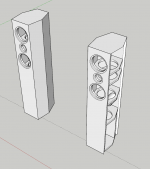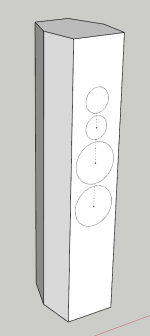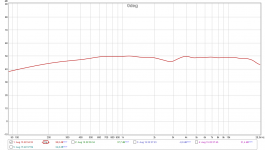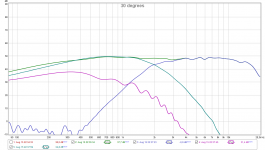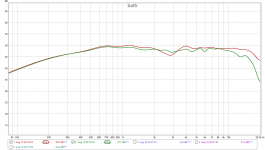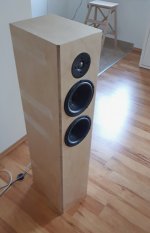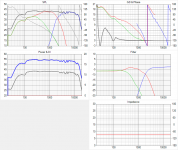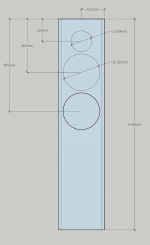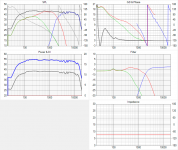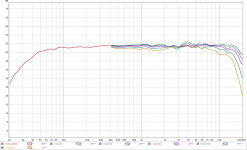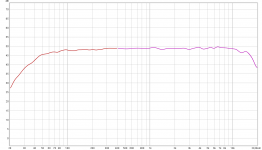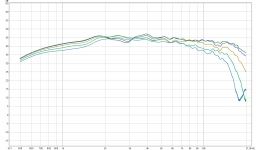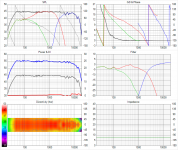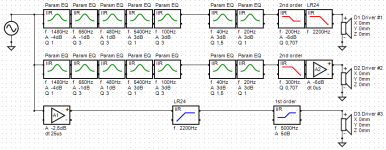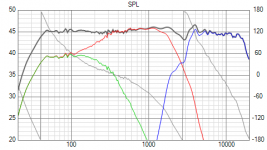2.5 way 18W/8531G00 and D2608/913000 with Hypex FA123
Hello!
I plan on building a two-way speaker that is powered by the new Hypex FA 122/123 amplifiers. I have been listening to Zaph ZRTs for close to 10 years now, and I wish for the capability to listen at higher levels without the bass drivers reaching their limit at low frequencies. Also, I want to build something new and different, which is probably even more important.
The speakers are currently using these drivers:
18W/8531G00: http://www.scan-speak.dk/datasheet/pdf/18w-8531g00.pdf
D3004/660000: http://www.scan-speak.dk/datasheet/pdf/d3004-660000.pdf
one on each side.
I want to add another bass driver to each cabinet (total of around 70 L, tuned to 30 Hz-35 Hz or so) and also swap the tweeters, as one of them is giving me constant problems after I changed a broken diaphragm. Air now comes in from the back, so the bass driver influences the treble, when it moves.
Sadly, the availability of replacement parts is not great, as even diaphragms are hard to get now (Germany). So, I would like to sell the two D3004/660000 and get other tweeters. The idea is to use R2604/833000 ring radiators, even though these may seem like a step back in quality. Crossover frequency would be around 2 kHz:
Link to datasheet: http://www.ase-scanspeak.de/chassis/discovery/tweeter/R2604-833000.pdf
Now I have a deciding question, as to how good the concept is: Is the chosen crossover frequency too high for the 18W? Off-angle, they drop hard at 2 kHz. If I choose a lower crossover frequency (say, 1.7 kHz), the R2604 significantly degrades in distortion performance. I could also use the D2604, which has much better distortion characteristics, but I would like to try a ring radiator. Generally, the linearity of the X2604 looks nice to work with.
In any case, the holes in the box (104 mm diameter) will fit any tweeter that I may want to use. The Hypex modules will give me the flexibility to adjust.
I do have access to measurement equipment and have some experience in building original designs with passive crossovers, as well as active (with DCX2496).
I would be happy to hear your comments on the concept! A little drawing is attached.
Here are some measurements of the XT25TG-30/04 which is very similar to the R2604 but lacks the double magnet: Test Peerless / Tymphany XT25TG-30/04 (Vifa XT-300/K4) – Heissmann Acoustics
Another link to measurements: Test Bench: Scan-Speak Discovery D2604/833000 1″ Wide Surround Silk Dome Tweeter | audioXpress
and of the D2604: Test Scan-Speak Discovery D2604 / 833000 – Heissmann Acoustics
Sorry that some of this is in german.
Thanks for your suggestions,
Adrian
Hello!
I plan on building a two-way speaker that is powered by the new Hypex FA 122/123 amplifiers. I have been listening to Zaph ZRTs for close to 10 years now, and I wish for the capability to listen at higher levels without the bass drivers reaching their limit at low frequencies. Also, I want to build something new and different, which is probably even more important.
The speakers are currently using these drivers:
18W/8531G00: http://www.scan-speak.dk/datasheet/pdf/18w-8531g00.pdf
D3004/660000: http://www.scan-speak.dk/datasheet/pdf/d3004-660000.pdf
one on each side.
I want to add another bass driver to each cabinet (total of around 70 L, tuned to 30 Hz-35 Hz or so) and also swap the tweeters, as one of them is giving me constant problems after I changed a broken diaphragm. Air now comes in from the back, so the bass driver influences the treble, when it moves.
Sadly, the availability of replacement parts is not great, as even diaphragms are hard to get now (Germany). So, I would like to sell the two D3004/660000 and get other tweeters. The idea is to use R2604/833000 ring radiators, even though these may seem like a step back in quality. Crossover frequency would be around 2 kHz:
Link to datasheet: http://www.ase-scanspeak.de/chassis/discovery/tweeter/R2604-833000.pdf
Now I have a deciding question, as to how good the concept is: Is the chosen crossover frequency too high for the 18W? Off-angle, they drop hard at 2 kHz. If I choose a lower crossover frequency (say, 1.7 kHz), the R2604 significantly degrades in distortion performance. I could also use the D2604, which has much better distortion characteristics, but I would like to try a ring radiator. Generally, the linearity of the X2604 looks nice to work with.
In any case, the holes in the box (104 mm diameter) will fit any tweeter that I may want to use. The Hypex modules will give me the flexibility to adjust.
I do have access to measurement equipment and have some experience in building original designs with passive crossovers, as well as active (with DCX2496).
I would be happy to hear your comments on the concept! A little drawing is attached.
Here are some measurements of the XT25TG-30/04 which is very similar to the R2604 but lacks the double magnet: Test Peerless / Tymphany XT25TG-30/04 (Vifa XT-300/K4) – Heissmann Acoustics
Another link to measurements: Test Bench: Scan-Speak Discovery D2604/833000 1″ Wide Surround Silk Dome Tweeter | audioXpress
and of the D2604: Test Scan-Speak Discovery D2604 / 833000 – Heissmann Acoustics
Sorry that some of this is in german.
Thanks for your suggestions,
Adrian
Attachments
Last edited:
After a bit of reading, I am thinking about adding an actual mid-driver, due to the compromise of using the 18W well into high frequencies. The 12MU looks very nice but is also quite expensive, so I could be using something like this instead:
http://www.scan-speak.dk/datasheet/pdf/10f-8414g10.pdf
This now looks a lot like an Ekta Grande, but a bit cheaper. The FA123 will allow me to drive three ways, too.
http://www.scan-speak.dk/datasheet/pdf/10f-8414g10.pdf
This now looks a lot like an Ekta Grande, but a bit cheaper. The FA123 will allow me to drive three ways, too.
Attachments
The R2604/8330 is the same as the XT25BG60-04 if i'm not wrong. There are measurements of the single (TG) and double magnet (BG) here:
Measurements and compare | HiFiCompass
The double magnet version is a little better than the single magnet but both are a step backwards from the 6600 IMO. The only thing the XT25 does better is the frequency response from 10kHz up.
I would not worry much about the woofers off axis response. It is acceptable as long as you cross around 2.5kHz or below. What will be far more of a problem is the centre-to-centre spacing with the tweeter. If you increase the crossover frequency, the vertical polar response gets worse. If you increase the spacing between woofer and tweeter, it gets worse. If you use an MTM configuration, it gets MUCH worse. Go have a look at it in Zaph's ZRT article.
If it were me, i'd modify the ZRT into a 2.5way design and retain the 6600.
Measurements and compare | HiFiCompass
The double magnet version is a little better than the single magnet but both are a step backwards from the 6600 IMO. The only thing the XT25 does better is the frequency response from 10kHz up.
I would not worry much about the woofers off axis response. It is acceptable as long as you cross around 2.5kHz or below. What will be far more of a problem is the centre-to-centre spacing with the tweeter. If you increase the crossover frequency, the vertical polar response gets worse. If you increase the spacing between woofer and tweeter, it gets worse. If you use an MTM configuration, it gets MUCH worse. Go have a look at it in Zaph's ZRT article.
If it were me, i'd modify the ZRT into a 2.5way design and retain the 6600.
Yes, the R2604 and XT25 are the same (mostly). They may have differences in airgap size, as far as I have read.
I am also certain that the 6600 is of better quality, but one of them is slightly defective (sometimes scratches, not airproof, probably related) and I cannot get replacement parts, which is a bit sad. Buying a new one is certainly possible, but not my favourite choice. I will need to do measurements on them to see how they do.
Let's say, I use a middriver (like the 10F fullrange, a 12m, 12mu ...) that I cross over to the tweeter at 3-3.5 kHz and to the woofers at around 500-1000 Hz. I am hoping that the higher distortion of the R2604 vs the D3004 at lower frequencies becomes irrelevant.
I saw that the 10F has rather high distortion in comparison with the 12M and especially 12MU. This driver also looks very adequate for use as a mid driver and offers low distortion:
http://www.scan-speak.dk/datasheet/pdf/12w-8524g00.pdf
A 2.5 way is also nice but contrary to my own initial concept, I would rather build a speaker with less compromises that I would use for longer (maybe 10 years again, or even more).
I am also certain that the 6600 is of better quality, but one of them is slightly defective (sometimes scratches, not airproof, probably related) and I cannot get replacement parts, which is a bit sad. Buying a new one is certainly possible, but not my favourite choice. I will need to do measurements on them to see how they do.
Let's say, I use a middriver (like the 10F fullrange, a 12m, 12mu ...) that I cross over to the tweeter at 3-3.5 kHz and to the woofers at around 500-1000 Hz. I am hoping that the higher distortion of the R2604 vs the D3004 at lower frequencies becomes irrelevant.
I saw that the 10F has rather high distortion in comparison with the 12M and especially 12MU. This driver also looks very adequate for use as a mid driver and offers low distortion:
http://www.scan-speak.dk/datasheet/pdf/12w-8524g00.pdf
A 2.5 way is also nice but contrary to my own initial concept, I would rather build a speaker with less compromises that I would use for longer (maybe 10 years again, or even more).
Last edited:
In the ZRT the C2C spacing between the woofer and tweeter is 15.2cm. If you use the 12M below the tweeter instead of the 18W, the C2C only becomes 11.9cm. Therefore just to equal the ZRT in polar response you can't cross higher than 15.2/11.9*1700hz = 2171Hz. To realise the polar benefit of using a smaller mid, you need to pick a tweeter with a smaller faceplate. Then you have to juggle the fact that tweeters with smaller faceplates typically don't have as good non-linear distortion. That's all part of multi-way speaker design.
I'm not sure that the 12M actually beats the 18W/8531 in midrange distortion either. The ZRT is quite a good execution of a 2-way because it uses exceptional drivers - a woofer which has no problems with distortion on the top end, and the tweeter which has no problems on it's bottom end. It will require an above average 3-way design to beat it.
I'm not sure that the 12M actually beats the 18W/8531 in midrange distortion either. The ZRT is quite a good execution of a 2-way because it uses exceptional drivers - a woofer which has no problems with distortion on the top end, and the tweeter which has no problems on it's bottom end. It will require an above average 3-way design to beat it.
Last edited:
Therefore just to equal the ZRT in polar response
I am guessing, vertical polar response? That did not cross my mind yet
Extending the ZRT to 2.5 way seems more and more sensible. I could even rebuild the Zaph crossover in DSP and correct for the room.
I found a test report of the 18W/8531G00 and you are right, the distortions are indeed quite low:
http://www.audiocomponents.nl/download/scan-speak/18W-8531G00 - Hobby HiFi 2002-3.pdf
The 12M is quite a bit worse above 1 kHz:
http://www.audiocomponents.nl/download/scan-speak/12M-4631G00 - Hobby HiFi 2003-2.pdf
Since the original idea seems pointless now, I will just stick with what I have for the tweeter and midwoofer and try to repair that tweeter. The remaining options are:
2.5 way enhancement
3 way with a larger woofer, like a 22W or 26W of some series. This would give me something similar to this:
Jensen-1071
A 22W seems to make no sense, since two 18W have more surface area (300mm^2) than one 22W (220mm^2). A 26W has around 320mm^2. Both larger drivers offer more excursion, though.
I wonder if 125 W on a large woofer may clip on peaks
2.5 way enhancement
3 way with a larger woofer, like a 22W or 26W of some series. This would give me something similar to this:
Jensen-1071
A 22W seems to make no sense, since two 18W have more surface area (300mm^2) than one 22W (220mm^2). A 26W has around 320mm^2. Both larger drivers offer more excursion, though.
I wonder if 125 W on a large woofer may clip on peaks
I think I have decided to go with the drawing of the first post and implement a 2.5 way speaker with MTM configuration and two 18W/8531g00. This is, so I can compare 2.5 way and 2 way by switching profiles on the Hypex module. Also, I prefer it optically over TMM.
Are there any objections with regard to a 2.5 way MTM, where the bottom woofer handles mids?
Thanks!
Are there any objections with regard to a 2.5 way MTM, where the bottom woofer handles mids?
Thanks!
I finally received the FA123 modules and built a speaker (pictures to follow).
Some facts:
2.5 way (two 18W/8531G00, tweeter in use is now the D2608/913000 because of the defects of the old tweeters)
Volume of around 60 L with 33 Hz tuning
2 kHz crossover between mid and tweeter
I noticed a stupid mistake that I made with tweeter placement. It is centered on the baffle which results in a diffraction dip of around 5 dB on axis at 2.8 kHz. Consequently, I designed the crossover with measurements from 15 and 30 degrees off axis, where the interference is not so visible.
Find the measurements attached. One measurement shows the on-axis measurement (0°) with the complete crossover, another shows the 30° measurement (with individual drivers) and the last one contains both (0° and 30°) for comparison. The measurements are strongly gated, so please ignore low frequencies. The bass region was tuned by means of nearfield measurements that I am not showing here.
The dip on axis is still bothering me. Should I ignore it, since it vanishes off axis anyway?
Presuming that I made a different baffle, where the tweeter is off-center (so that on-axis frequency response is linear), would I get problems off-axis instead?
Thanks for any feedback!
Some facts:
2.5 way (two 18W/8531G00, tweeter in use is now the D2608/913000 because of the defects of the old tweeters)
Volume of around 60 L with 33 Hz tuning
2 kHz crossover between mid and tweeter
I noticed a stupid mistake that I made with tweeter placement. It is centered on the baffle which results in a diffraction dip of around 5 dB on axis at 2.8 kHz. Consequently, I designed the crossover with measurements from 15 and 30 degrees off axis, where the interference is not so visible.
Find the measurements attached. One measurement shows the on-axis measurement (0°) with the complete crossover, another shows the 30° measurement (with individual drivers) and the last one contains both (0° and 30°) for comparison. The measurements are strongly gated, so please ignore low frequencies. The bass region was tuned by means of nearfield measurements that I am not showing here.
The dip on axis is still bothering me. Should I ignore it, since it vanishes off axis anyway?
Presuming that I made a different baffle, where the tweeter is off-center (so that on-axis frequency response is linear), would I get problems off-axis instead?
Thanks for any feedback!
Attachments
Last edited:
Looks good to me! Just toe them a little in/out from your listening position to smooth the diffraction ripple. Add some boost to the top octave if needed to account for this.
When running an MTM as 2.5way, it can often be better to run the top woofer as the 0.5-way. If the bottom woofer is the 0.5way then the midrange droops when you stand up.
When running an MTM as 2.5way, it can often be better to run the top woofer as the 0.5-way. If the bottom woofer is the 0.5way then the midrange droops when you stand up.
I think the ring radiator + 18W/8531 is an excellent idea. 
For a couple of reasons. I own the Peerless version of that tweeter, it is not exactly the same, but it's almost as good. It's a wonderful tweeter, but the dispersion is totally different to your original. The RR is pretty narrow. The dome you suggested is super-wide.
Also, the 18W/4531 and 8531 measure much better than spec, they can do 2kHz quite nicely. I have them crossed over to Mundorf AMT's around 1,800, but I could have pushed it.
The upper end of the frequency range is really a lost smoother and cleaner than you would think from the spec sheet. May have been an engineering change, because I don't think Zaph's specs show it, but Troels has written about this oddity of SS FR measurements too.
Best,
E
For a couple of reasons. I own the Peerless version of that tweeter, it is not exactly the same, but it's almost as good. It's a wonderful tweeter, but the dispersion is totally different to your original. The RR is pretty narrow. The dome you suggested is super-wide.
Also, the 18W/4531 and 8531 measure much better than spec, they can do 2kHz quite nicely. I have them crossed over to Mundorf AMT's around 1,800, but I could have pushed it.
The upper end of the frequency range is really a lost smoother and cleaner than you would think from the spec sheet. May have been an engineering change, because I don't think Zaph's specs show it, but Troels has written about this oddity of SS FR measurements too.
Best,
E
Yes, I also noticed! I barely touched the individual driver responses. Also, the tweeter is very smooth. I will upload my measurements and DSP configuration later. A ring radiator would clearly have helped with the edge dispersion.Also, the 18W/4531 and 8531 measure much better than spec, they can do 2kHz quite nicely.
The speaker is actually no longer an MTM, due to the total height that would have been required. Find attached a (quite horrible, sorry) picture of the first speaker. Surfaces still need finishing and the back is not yet glued in. Also, I need to build a second one.
As you can see, it looks nothing like the proposed design. I built a test box of the design I showed in the first post, but I did not like it much. That is why it is now much simpler in construction.
Attachments
Last edited:
Here is some more data that could be interesting. I did new measurements where I compensated the near field response for baffle step. I did filter simulation in VituixCAD which helps a lot.
Find attached the simulation files for reference. The archive includes the VituixCAD file and the .frd files of tweeter (D2608/913000) and woofer (18W/8531G00), measured at around 15°. I included a drawing of the baffle, if someone is interested in rebuilding. There are 14 mm chamfers that are not really required, because they do not do much acoustically.
Below, you also find the final crossover as simulated with VituixCAD. It measures very close to the simulated version, so I am happy with that.
I do not include the vent response in the measurements at this point, but it should be OK. If you have suggestions or see room for improvement, I would be very happy to hear your remarks. Feel free to play around with the simulation file.
Find attached the simulation files for reference. The archive includes the VituixCAD file and the .frd files of tweeter (D2608/913000) and woofer (18W/8531G00), measured at around 15°. I included a drawing of the baffle, if someone is interested in rebuilding. There are 14 mm chamfers that are not really required, because they do not do much acoustically.
Below, you also find the final crossover as simulated with VituixCAD. It measures very close to the simulated version, so I am happy with that.
I do not include the vent response in the measurements at this point, but it should be OK. If you have suggestions or see room for improvement, I would be very happy to hear your remarks. Feel free to play around with the simulation file.
Attachments
Last edited:
I made a few final measurements after some more tweaking. Especially the bass was slightly too low in level. Find attached measurements from different angles, as well as an isolated 30° measurement.
I will upload the final filter configuration, in case someone is interested.
I will upload the final filter configuration, in case someone is interested.
Attachments
It turns out, I forgot to include microphone calibration during my work  My microphone reads 4 dB high towards higher frequencies, so I had to change some things.
My microphone reads 4 dB high towards higher frequencies, so I had to change some things.
I moved the crossover frequency up to 2200 Hz, because directivity looked a bit more even. When repeating the measurements, I noticed that both of my D2608 tweeters drop significantly in amplitude from 10 kHz onward.
Is that normal or is my measurement incorrect? I have not seen this behaviour anywhere else.
Find the new simulation results, showing 30° measurements, as well as raw tweeter measurements (0-60°, gated at 1m) attached. The 0° simulation is attached separately.
The new crossover is also attached. I added some bass boost for reaching a lower frequency limit of 34 Hz (-3dB), 28 Hz(-6 dB).
I moved the crossover frequency up to 2200 Hz, because directivity looked a bit more even. When repeating the measurements, I noticed that both of my D2608 tweeters drop significantly in amplitude from 10 kHz onward.
Is that normal or is my measurement incorrect? I have not seen this behaviour anywhere else.
Find the new simulation results, showing 30° measurements, as well as raw tweeter measurements (0-60°, gated at 1m) attached. The 0° simulation is attached separately.
The new crossover is also attached. I added some bass boost for reaching a lower frequency limit of 34 Hz (-3dB), 28 Hz(-6 dB).
Attachments
Last edited:
- Status
- This old topic is closed. If you want to reopen this topic, contact a moderator using the "Report Post" button.
- Home
- Loudspeakers
- Multi-Way
- Active MTM with 18W/8531G00 and some tweeter
